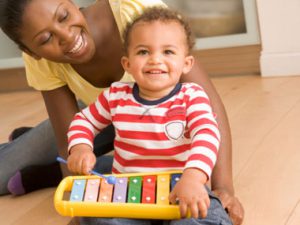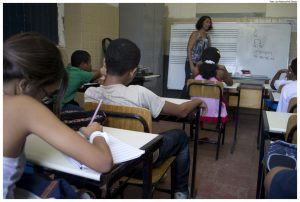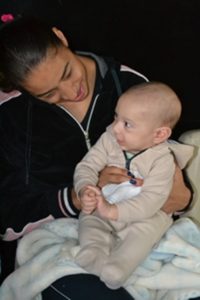
Still during pregnancy, it is heartbeats that give parents the assurance that there is already a new person growing within that womb. During childbirth, the baby’s cry is the most anticipated sound, as if it were saying hello to its new world. On the outside, it is the mother’s voice that soothes the baby and begins to establish its first affective ties. Then come lullabies, singing rounds, the first birthday with the sound of the classic “Happy Birthday to You,” and so life goes on, always full of sonorities and meanings.
Soundtrack to our lives, music accompanies us even before we are born. Music therapist and educator Melissa Lima explains that “even in intrauterine life, in the 5th month of pregnancy, a baby’s peripheral auditory system is already evolved, both anatomically and physiologically. From then on, the baby can hear external and internal noise, and is able to hear and distinguish the mother’s voice. At birth, it shows that it is able to recognize its mother’s voice, expressing emotions, changes of behavior and of heartbeats.”
The educator provides practical examples of how music can help mothers and babies starting at pregnancy. “Music can have an effect during the intrauterine period, rocking, soothing, promoting the well-being of the mother and baby, and helping to create affective ties between them. After birth, the baby has a perceptible change in mood when it recognizes these rhymes or songs, they stop its crying and promote a feeling of comfort,” she says.
“The beauty of songs nourishes the baby and the musical history of the family and future generations”
Melissa Lima
But for this to work, the coordinator of The House of Music, a space for Music Education and Musicalization, provides some tips. “It is important to observe and care for quality of sounds, conversations, intonation and songs so that they promote a more adequate sound landscape. Lullabies are a good choice for the baby’s repertoire, since they are more melodious and feature lyrics that can be adapted (with the name of the baby, for example),” says the specialist.
Music can also educate. This is shown by studies together with the practical observation of those who deal directly with children. “There are countless indirect benefits offered by music to those practicing it, which have already been proven by science through research studies, some of them conducted over decades,” says Professor Danilo Tomic, who holds a degree in Composition from the University of São Paulo (USP).

With 17 years of classroom experience, the educator believes that, in addition to content that is directly musical, responsible for developing hearing, concentration, mathematical and proportional thinking, other content related to students’ social relations is also developed based on musical practices, especially when they are collective. The ability to hear, respect the others and the notion of responsibility within a group are some of them. “The ability to remain silent and concentrate provides great benefits for students’ school performance,” emphasizes Tomic.
“A child is born with well-developed senses that are more affected by musical language. Sound allows one to travel and transform oneself”
Danilo Tomic
Holding a Master’s degree from the State University of Campinas (UNICAMP), Deborah Rossi says that contact with musical language stimulates important areas of the brain and helps develop logical and creative thinking, in addition to reinforcing important health-related issues, such as posture, breathing, healthy eating and the fight against drug use.

It is not by chance that music has been part of all school curriculums for basic education in Brazil since 2012 (Law No. 11,769) and also represents a way of transmitting popular culture. “Culture educates and develops critical thinking for citizens, which is essential in today’s world,” says Rossi. With a Bachelor’s degree in Conducting from UNICAMP, the professor criticizes the lack of regulation of music education. “Today, any teacher can give music lessons. Academic training is not necessary. And the great majority is not ready for this,” she adds.
“Music is one of the most genuine means of expression that we practice from an early age. As children, we have no ‘shame’ when expressing ourselves by singing”
Deborah Rossi

For Tomic, musical practice in the school environment is part of each student’s overall education and he supports teaching students to play instruments and creation of a student orchestra within the school. He believes that like choirs, orchestras are “very powerful education tools.” “The mental state of a person involved in collective music, as in the case of an orchestra, is ideal for learning,” he says.
MUSIC AS MEDICINE
It is not just in education that music has positive effects. In addition to educating, music also has health benefits. As when a mother sings to her baby, thus establishing a bond.

“Medicine already recognizes the use of music as a tool for promoting health and well-being, and music therapy is an increasingly important scientific discipline,” says music therapist Melissa Lima. The expert mentions studies, which prove, for example, that music therapy can increase maternal breastfeeding rates among mothers of premature newborns. She also adds that, in Argentina, studies lasting over two decades show that prenatal music therapy stimulation has helped in the labor process, from reducing mothers’ anxiety and the pain of contractions, to welcoming babies at birth.
In Brazil, an important step in this direction was the recent approval of the inclusion of music therapy – which is the use of music elements (sound, rhythm, melody and harmony) for therapeutic purposes – as a procedure regularly offered by the public health system.
Creator and coordinator of the Passarim social project, which uses music as an educational tool for children and adolescents in vulnerable social positions, Danilo Tomic has no doubt about the different ways music provides therapeutic benefits. According to him, the cure can be either physical as in social and family relations or psychological, based on increasing self-esteem. “At Passarim the social cure is most visible. People dedicated to music become more calm and mentally organized,” he says.

Deborah Rossi, who is a professor at the Municipal Conservatory of Guarulhos, in the state of São Paulo, where she deals with people “with many limitations and financial difficulties,” says she has also seen many transformations take place based on music education. “I have seen many examples of children and young people, with no future prospects, who entered the university and are now fellow professionals, sharing a bit of what they learned and helping to change the lives of other young people.”
Helping to change and improve the lives of children and adolescents is what we at the Criança é Vida (Child is Life) Institute have been doing for 20 years. And it is because we believe that through songs and games the dissemination of knowledge is made with lightness and joy, promoting retention of the concepts taught, we also invest in music as an important tool to help learning. We developed a CD of educational songs to use in our projects. Learn about our music here: http://criancaevida.org.br/quem-somos/cd-crianca-e-vida/
“What really changes people’s lives, stays within them and is multiplied. Music has this ability,” says Professor Rossi.

See also (pages in portuguese):
Music during pregnancy
http://guiadobebe.uol.com.br/musica-na-gestacao/
Health benefits of music
http://g1.globo.com/bemestar/noticia/2013/06/musica-acalma-ajuda-na-atividade-fisica-e-tambem-pode-aliviar-dores.html
Music helps in children’s learning
http://revistacrescer.globo.com/Revista/Crescer/0,,EMI66583-15153,00.html
Music educates
http://www.todacriancapodeaprender.org.br/cantar-educa-o-que-as-criancas-aprendem-cantando-e-ouvindo-cancoes/
The Passarim Project
http://www.associacaopelafamilia.org.br/projetos/216-2/
The House of Music
http://espacoacasadamusica.blogspot.com.br/